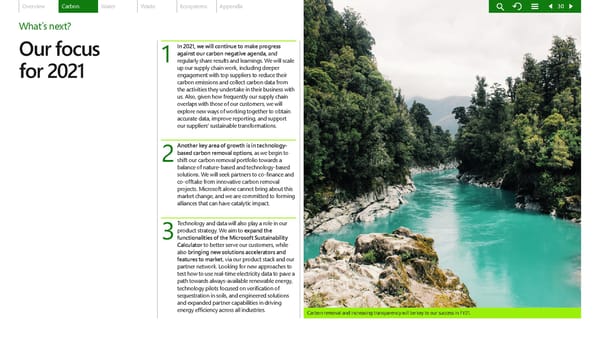Overview Carbon Water Waste Ecosystems Appendix 30 What΄s next? In 2021, we will continue to make progress Our focus against our carbon negative agenda, and 1 regularly share results and learnings. We will scale up our supply chain work, including deeper for 2021 engagement with top suppliers to reduce their carbon emissions and collect carbon data from the activities they undertake in their business with us. Also, given how frequently our supply chain overlaps with those of our customers, we will explore new ways of working together to obtain accurate data, improve reporting, and support our suppliers’ sustainable transformations. Another key area of growth is in technology- 2based carbon removal options, as we begin to shift our carbon removal portfolio towards a balance of nature-based and technology-based solutions. We will seek partners to co-finance and co-offtake from innovative carbon removal projects. Microsoft alone cannot bring about this market change, and we are committed to forming alliances that can have catalytic impact. Technology and data will also play a role in our 3product strategy. We aim to expand the functionalities of the Microsoft Sustainability Calculator to better serve our customers, while also bringing new solutions accelerators and features to market, via our product stack and our partner network. Looking for new approaches to test how to use real-time electricity data to pave a path towards always-available renewable energy, technology pilots focused on verification of sequestration in soils, and engineered solutions and expanded partner capabilities in driving energy efficiency across all industries. Carbon removal and increasing transparency will be key to our success in FY21.
 Microsoft Environmental Sustainability Report 2020 Page 29 Page 31
Microsoft Environmental Sustainability Report 2020 Page 29 Page 31